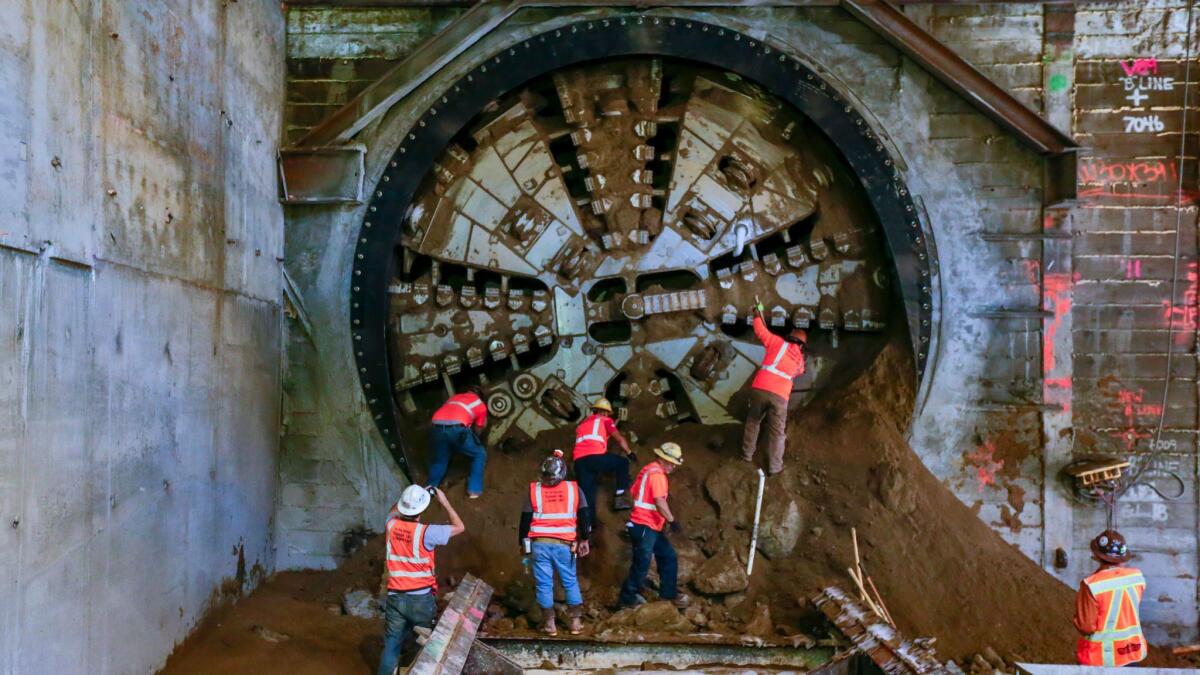The Crenshaw Line is a start, but L.A.’s most transit-dependent neighborhoods need more options

- Share via
Access to safe, reliable and affordable mass transit opens opportunities and makes life less stressful. But even as rapid transit options have expanded across Los Angeles, hundreds of thousands of South and Central Los Angeles residents have been left out. As a result, a large swath of the city’s black and Latino residents are unable to fully access, enjoy and participate in L.A.’s job markets, healthcare services and cultural amenities because they are badly underserved by the L.A. Metro system.
While the south and central parts of the city have a high percentage of residents dependent on public transportation, the area is a virtual desert of mass transit. Seven of Metro’s 10 highest ridership bus routes serve Central Los Angeles’ low-income residents, but those residents have little access to rail options. Instead, they are forced to rely on buses that travel at a snail’s pace on clogged surface streets at speeds averaging seven to nine miles per hour.
For the record:
4:33 p.m. Sept. 30, 2019An earlier version of this story said the Crenshaw line was scheduled to open in 2021. It is scheduled for mid-2020.
A new Metro line, extending from the Crenshaw area south through L.A.’s historic African American neighborhoods to Inglewood, is expected to open in mid-2020, and that will be an excellent start. But this route does not make it easier to travel north — where a huge number of good jobs exist. It is a social justice imperative that the mass transit inequities that handicap residents of South and Central Los Angeles residents be addressed.
In the coming months, the L.A. Metro Board can take concrete steps to correct some of the problems by accelerating the timetable for extending the Crenshaw/LAX Line northward to Hollywood, with connections to the Metro’s Purple and Red Lines along the way.
The so-called Northern Extension would stretch for about eight to 10 miles, depending on the route chosen, and it would tremendously multiply the travel options and opportunities for South L.A. residents by making it far easier to travel north of the Santa Monica Freeway, the city’s symbolic, if not always real, “color boundary.”
The Northern Extension would provide access, either directly or in combination with the Purple Line, to the Wilshire Corridor, West Hollywood, Hollywood and Westwood and to such venues as Cedars-Sinai Medical Center, the VA Hospital and the Los Angeles County Museum of Art.
That’s the dream.
Unfortunately, the Metro Board’s current plans do not call for construction of the Northern Extension to even begin until 2041. And the line would not be operational until 2047 — 28 years from now. Do we really want additional generations of minority residents to be denied full access to L.A.’s economic and cultural life because they can’t travel easily?
To be fair, the Metro Board has been inching toward consideration of possibly expediting construction of the Northern Extension. The operative words, however, are “inching” and “possibly.”
Last month, Metro solicited bids for a study of the environmental impacts of the Northern Extension that could make this project shovel-ready in one or two years. In the next few months, the agency will be ready, should it choose, to pick a firm to conduct the study.
The Board has also OKd a study to reduce the number of possible routes for the Northern Extension, from five to two or three, and it has encouraged the cities of West Hollywood and Los Angeles to identify possible new funding sources to pay for the Northern Extension. West Hollywood is releasing the preliminary results of its funding study early next month.
These are all welcome signs. But none constitutes an iron-clad Metro Board commitment to an accelerated construction timetable for the Northern Extension.
A case can also be made that the Northern Extension — built sooner, not later — would energize locally-grown business and cultural opportunities in South and Central Los Angeles. It would provide a huge boost to Leimert Park, the epicenter of African American cultural activities. It would increase access to the soon-to-be completed Baldwin Hills Crenshaw shopping and entertainment complex and to Destination Crenshaw, a visionary public art and streetscape project fostered by the late Nipsey Hussle.
Hundreds of thousands of transit-dependent, traditionally disadvantaged residents have already waited far too long to enjoy the benefits of our region’s multibillion-dollar rail system. It would be unconscionable to make them wait decades more.
Herb Wesson is president of the Los Angeles City Council. He represents the 10th council district.
More to Read
A cure for the common opinion
Get thought-provoking perspectives with our weekly newsletter.
You may occasionally receive promotional content from the Los Angeles Times.









